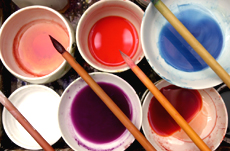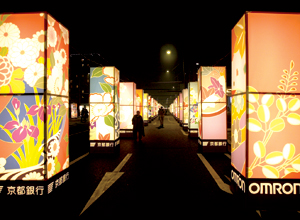
 |


Hand-painted yuzen dying is a technique
used to dye silk fabrics, such as pieces of silk crepe around 12 m long,
and involves using a brush to insert color within a pattern enclosed in fine
thread. It became popular in Kyoto during the Genroku Period (1688-1704), since when
it has mainly been used for kimono dying
|
 |
|
|

Kyo-Yuzen
Japan Style System Co., Ltd.

Representative Director:
Yunosuke Kawabe
 |
|
|

New value through the combination of cutting-edge technology with the Kyo-yuzen dying Kawabe has known since birth

If the hand-painted patterns used in yuzen dying
could be produced by using computer graphics (CG), this would free them from the
kimono to carve out a new era. This inspiration is now proving itself true in a number
of different areas, notably the swimsuits for the Japanese synchronized swimming team at
the 2004 Athens Olympics. |
|

 |
 Yunosuke Kawabe was born into a hand-painted yuzen dying workshop.
An attraction to a poster for the Montreal Olympics, however, led to his
being sucked into the world of graphic design. Kawabe searched for jobs in
advertising agencies in order to progress along that path, and began work
in earnest. He then returned to his family home to help out, but he had
glimpsed the glittering world outside, so different to the heritage industries,
and found himself bored and dissatisfied with conventional yuzen dying. He engaged
in a repeated process of trial and error in attempting new developments, at the end
of which he arrived at an inspiration: Integrating the traditional yuzen designs passed
down within the Kawabe family with the computer technology that was swiftly making inroads.
By “factorizing” the yuzen dying production process, he worked out a method for
creating new products by recreating it on the computer. This was the starting point for CG Yuzen.
Yunosuke Kawabe was born into a hand-painted yuzen dying workshop.
An attraction to a poster for the Montreal Olympics, however, led to his
being sucked into the world of graphic design. Kawabe searched for jobs in
advertising agencies in order to progress along that path, and began work
in earnest. He then returned to his family home to help out, but he had
glimpsed the glittering world outside, so different to the heritage industries,
and found himself bored and dissatisfied with conventional yuzen dying. He engaged
in a repeated process of trial and error in attempting new developments, at the end
of which he arrived at an inspiration: Integrating the traditional yuzen designs passed
down within the Kawabe family with the computer technology that was swiftly making inroads.
By “factorizing” the yuzen dying production process, he worked out a method for
creating new products by recreating it on the computer. This was the starting point for CG Yuzen.
 Kawabe has launched yuzen on a new stage, that of technology,
and is in the process of extending its possibilities into a range of
other areas such as swimsuits, interiors, and bookbinding. As Kawabe
himself has mastered the techniques of hand-painted yuzen, he is able to
incorporate these traditional methods into the development of CG yuzen.
One point for producing good work is color distribution, with each workshop
having different methods of creating good yuzen colors through their combinations,
intensities, and other characteristics. This is what “brings out the flavor”
of yuzen, and Kawabe says he is able to produce distinctive work that makes him feel
“something’s right.”
Kawabe has launched yuzen on a new stage, that of technology,
and is in the process of extending its possibilities into a range of
other areas such as swimsuits, interiors, and bookbinding. As Kawabe
himself has mastered the techniques of hand-painted yuzen, he is able to
incorporate these traditional methods into the development of CG yuzen.
One point for producing good work is color distribution, with each workshop
having different methods of creating good yuzen colors through their combinations,
intensities, and other characteristics. This is what “brings out the flavor”
of yuzen, and Kawabe says he is able to produce distinctive work that makes him feel
“something’s right.”
This is a sort of “peculiarity” possessed by each yuzen workshop,
and is something that cannot be imitated by outsiders even should they try.
Accordingly, Kawabe’s works can be described as expressing the implicit
knowledge passed down in the family through the generations and in which
he can be confident, not with the brush but with the new tools of computer
and CG. This is why those who look closely can discern ineradicable
similarities between the CG Yuzen created by Yunosuke and the hand-painted
yuzen kimono made by his father Zenji. This is an outstanding embodiment
of the inheritance of the core of traditional culture together with new
business innovation.
Kyoto is that rare place, a city in which heritage industries
and cutting-edge high-tech industries coexist. On the one hand
is the ancient Kyoto of Nishijin brocade, yuzen dying, Kiyomizu
pottery, and Kyoto dolls. On the other is the new Kyoto in which
corporations such as Kyocera, Omron, Rohm, and Nintendo are taking
shape at the leading edge of technology. Looking at our 21st-century
world, perhaps Japan’s strengths and presence can be summarized by
the twin realms of culture and technology. Japan’s immeasurable
potential lies in the integration of both of these. Kawabe, who has
inherited yuzen in his blood, has created a pioneering fusion. The
energy arising from this integration of traditional culture and
technology speaks to what lies latent in Kyoto’s depths.
|

 |


Kawabe designed the swimsuits for the
Japanese synchronized swimming team at the 2004 Athens Olympics.
The design took kabuki as its motif. The Japanese swimmers won
silver medals in both the team and duet events.



A hand-painted kyo-yuzen ceremonial kimono created by Kawabe’s
father Zenji. Although he cannot yet match his father’s skills,
honed during the more than 50 years of his career, Yunosuke has inherited
the core of traditional culture that his father has unwaveringly passed down.
|



He also designed the large 3-m-tall standing lanterns
lit on December 31, 2000 for the Lantern Festival held
to commemorate the beginning of the 21st century. Oike Street
was lined with 250 of these lanterns, forming an impressive sight.



Kawabe has set up a graphic design studio in his yuzen workshop,
and is engaged in the creation of new yuzen patterns by using computer
graphics. He says that yuzen made with CG and hand-painted yuzen both have
their strengths and weaknesses, and neither can be said to be the perfect
textile. Kawabe factorizes both of these and puts them back together, believing
that by combining the strengths of both techniques yuzen can move forward into a new era.
|
|
|

